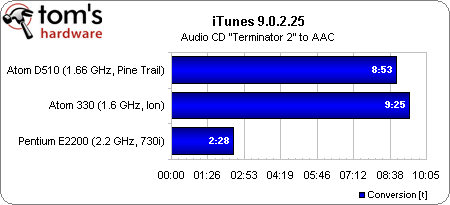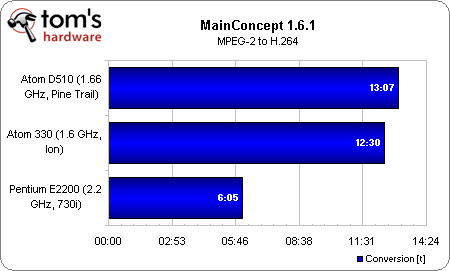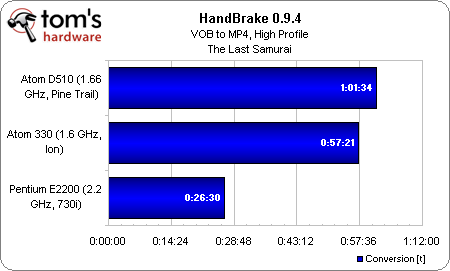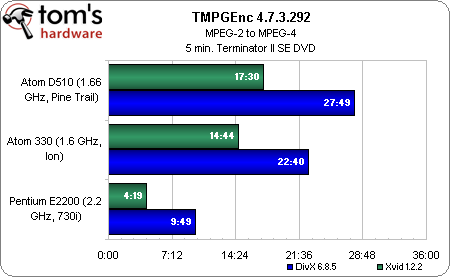Intel’s Atom D510 And NM10 Express: Down The Pine Trail With D510MO
Benchmark Results: Transcoding
Right off the bat we’re able to tell the difference between a processing architecture designed for the desktop and one built with low power consumption as the first priority. Nettop connoisseurs will say that the point of a platform like Pine Trail is its power draw. But when you make the leap to desktop computing, it’s important to take the tasks we take for granted, like a simple iTunes transcode, into consideration.
The Atom D510 shaves more than 30 seconds off of an Atom 330/Ion, but both are blown out of the water by the Pentium E2200. We’re reminded that, in order to use any of these super low-power setups for anything beyond Web browsing or word processing, you’ll need to be particularly patient.
Whereas iTunes isn’t threaded, MainConcept is. Thus, the dual-core Hyper-Threading-enabled Atoms stack up to the dual-core Pentium E2200 a little better. Even still, you’re looking at 12-13 minutes on either Atom setup or roughly six minutes on the Pentium.
It’s interesting that the Ion-based arrangement actually does better here, despite its less-power processor and slightly-lower memory bandwidth. This is a trend we’ll see continue in some of the other media-oriented tests, and a trend that will be bucked in the benchmarks more centered on storage.
New to the Tom’s Hardware 2010 benchmark suite (and a popular request from our readers) is the freely-available HandBrake 0.9.4. In this test, we’re using the High Profile to transcode the first .vob from The Last Samurai into .mp4.
It’s a process that takes roughly one hour on either of the Atoms and less than 30 minutes on the Pentium. And once again, the dual-core Atom 330 is able to slide past the new Atom D510 by finishing the transcode job four minutes faster.
Using the latest version of TMPGEnc, DivX, and Xivd, we again see the Atom 330 beating out its successor coupled with Nvidia’s Ion platform. Of course, in Xvid, which isn’t very well threaded, the Pentium E2200 boasts its most significant lead. Shifting over to DivX, where threading optimizations smile warmly on the inclusion of Hyper-Threading, the Atoms make up some of their performance deficit (though the D510 still takes almost three times as long to finish the job).
Get Tom's Hardware's best news and in-depth reviews, straight to your inbox.
Finally, here again we see this-generation’s Atom D510 getting bested by the Atom 330 on Nvidia’s Ion platform.
Current page: Benchmark Results: Transcoding
Prev Page Benchmark Results: Synthetics Next Page Benchmark Results: Productivity Apps-
It certainly is an improvement over the weak hearted Atom but I was expecting a bit more bang for the CPU's capabilities. Hopefully this will make Mini-ITX boards cheaper and more readily available for small servers and back up applications.Reply
-
scook9 My dad was looking at netbooks because he wanted something portable. What he ended up buying was the Dell Inspiron Mini 11z (not normally an inspiron fan). It has a Pentium Dual Core and the GM45 chipset (with HDMI output not VGA). This little 11" notebook gets over 6 hours of battery life and will run circles around either generation of atom processors and their chipsets/graphics. Yes the 11z did cost more than the other netbooks, but you got alot more for it, something to think about :)Reply -
matt87_50 wow, thats pretty terrible, one wonders how much better that new cpu integrated graphics is than the old chip set integrated? as basic as the ion system is, you can do anything with it, media center decoding HD, playing a couple of games, and as a file server, all with the lowest power consumption, this new one seems like its only good for the latter, and its only 3W less power.Reply
however, a file server / NAS alternative with the lowest possible power consumption is exactly what I'm after, so maybe its perfect for me, but I'd probably still go ION just because of the flexibility it offers in the future, should I get a new file server to replace it.
as for netbooks. If its a computer, I wanna be able to play games on it, and lets not forget about flash going 3D and hardware accelerated, I'd still go ION.
honestly, I wonder how they could make a GPU that crap in this day and age, the one in the iPhone and droid would be more powerful... -
little-ninja-man I just hop with this lower power usage we might see dual core atoms in netbooksReply -
liquidsnake718 I guess its not bad for beginners. I also have a netbook as my 3rd option.... I am rather enjoying the portability and functionality. As a HTCP or mini media center this sounds interesting for beginners that dont know how to build a PC... its almost plug and play..... this is a good option for them. I would prefer to get a mini-ITX board with at least a core 2 duo and build from there...... but then again, a PS2 is currently the king of this realm and you cannot compare as it has an HDMI, Great games, blu-ray, wifi, and everything one would need in this segment. Sorry the Cell is still far superior in this field!Reply -
tacoslave http://www.newegg.com/Product/Product.aspx?Item=N82E16813128342Reply
http://www.newegg.com/Product/Product.aspx?Item=N82E16819103706
quad core plus micro atx = amd win
-
djiezes Lack of HDMI, DVI or hardware accelerated decoding for MPEG4, x264 or h264 really does not make sense for a CPU/chipset that orients itself towards the desktop.Reply
Originally I thought this new chip might've made sense for htpc use. ION still beats it & ION2 is coming soon. An ordinary low powered desktop CPU for htpc use still makes more sense. AMDs Athlon X2 240E for example (45W) or maybe an Intel Pentium E3200 or alike. -
djiezes Lack of HDMI, DVI or hardware accelerated decoding for MPEG4, x264 or h264 really does not make sense for a CPU/chipset that orients itself towards the desktop.Reply
Originally I thought this new chip might've made sense for htpc use. ION still beats it & ION2 is coming soon. An ordinary low powered desktop CPU for htpc use still makes more sense. AMDs Athlon X2 240E for example (45W) or maybe an Intel Pentium E3200 or alike. -
yankeeDDL I have a question regarding the power efficiency. We see that in most tasks the Atoms are about 2X slower than the Pentium, and it seems to consume about 3~3,5X less under load.Reply
I wonder if a real/fair comparison of power consumption should be made differently.
For example: if I watch a DVD on an Atom I need, say, 100% CPU, while on a Pentium I will need only 50% of it.
So I will have the Atom burning power under full load vs 50% of the Pentium.
In other words: the Pentium is much more powerful, so it does not need to run full speed to do the same.
So, is there really an advantage in the Atom? Can you get the power/performance ratio of an Atom by simply underclocking a Pentium by few %?




